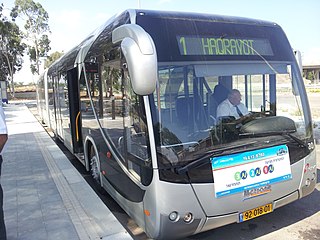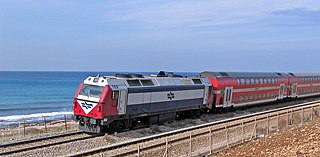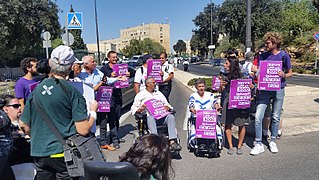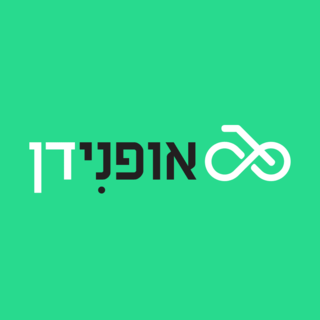
Transportation in Israel is based mainly on private motor vehicles and bus service and an expanding railway network. A lack of inland waterways and the small size of the country make air and water transport of only minor importance in domestic transportation, but they are vitally important for Israel's international transport links. Demands of population growth, political factors, the Israel Defense Forces, tourism and increased traffic set the pace for all sectors, being a major driver in the mobility transition towards railways and public transit while moving away from motorized road transport. All facets of transportation in Israel are under the supervision of the Ministry of Transport and Road Safety.

Egged Transportation Ltd is the largest transit bus company in Israel. Egged's intercity bus routes reach most Israeli cities, towns, kibbutzim and moshavim, and the company operates urban city buses throughout the country. It also operates in Poland and the Netherlands through a subsidiary.

The Tel Aviv Light Rail, also known as Dankal is a mass transit system for the Tel Aviv metropolitan area in central Israel. The system will include different modes of mass transit, including rapid transit (metro), light rail transit (LRT), and bus rapid transit (BRT). Overseen by the government agency NTA, the project will complement the intercity and suburban rail network operated by Israel Railways.

Jerusalem Light Rail is a light rail system in Jerusalem. Currently, the Red Line is the only one in operation, the first of several light rail lines planned in Jerusalem.

The Metronit, also spelled Matronit, is a bus rapid transit (BRT) system in Haifa, Israel.

Rail transport in Israel includes heavy rail as well as light rail. Excluding light rail, the network consists of 1,384 kilometers (860 mi) of track, and is undergoing constant expansion. All of the lines are standard gauge and as of 2023 approximately one-fifth of the heavy rail network is electrified, with additional electrification work underway. A government owned rail company, Israel Railways, manages the entire heavy rail network. Most of the network is located on the densely populated coastal plain.

The Tel Aviv–Jerusalem railway is a railway line in Israel connecting the city of Tel Aviv with Jerusalem. The line serves as the main rail link between the two cities, complementing the old Jaffa–Jerusalem railway. As such, the railway is often referred to in Israel as the high-speed railway to Jerusalem to distinguish it from the older, longer and slower line. In spite of that name, the line is not high-speed under the definition used by the International Union of Railways: both its design speed of 200 km/h (125 mph) and its current operational speed of 160 km/h (99 mph) are below the 250 km/h (155 mph) threshold used by the UIC to define high-speed railways, and it is traversed by IR's regular rolling stock instead of the UIC requirement for specially-designed high-speed trains.

The Red Line is the first section of a light rail system in the Tel Aviv metropolitan area, known as the Tel Aviv Light Rail. The line runs from Bat Yam in the south to Petah Tikva in the northeast with a significant portion of it underground. The total cost of the red line is estimated at NIS 11 billion or, approximately US$3 billion. Construction began in 2011, with the testing phase of the line beginning only a decade later, in 2021. After numerous delays concerning the security and safety of the line, it eventually opened on August 18, 2023 with a 100,000+ daily ridership over just 8 hours of operation.

The Coastal railway line is a mainline railway in Israel, which begins just south of the Lebanon-Israel border on the Mediterranean coast, near the town of Nahariya in Northern Israel and stretches almost the entire Mediterranean coast of the country, to just north of the border with the Gaza Strip in the south.

The Railway to Karmiel is a railway linking Haifa and Karmiel in northern Israel. It opened in 2017 and consists of a double track standard gauge railway stretching for 23 km from near Acre (Akko) to Karmiel. It branches eastwards from the Coastal Railway between the Kiryat Motzkin Railway Station and the Acre Railway Station and includes a 5 km long tunnel in the mountainous region near the eastern end of the line. Most of the route is in the vicinity of Highway 85. There are two stations on the railway: Ahidud and Karmiel.

Highway 45 is the official designation of a 3.3 km stretch of road forming a continuous connection between Route 443 from the Tel Aviv Metropolitan Area and Highway 50 to central Jerusalem and a 1.4 km spur serving the Atarot Industrial Park.
The High-speed railway to Eilat (Med-Red) is a proposed Israeli railway that will enable the connection of the main Israeli population centers and Mediterranean ports to the southern city of Eilat on the Red Sea coast, as well as serve commercial freight between the Mediterranean Sea and Red Sea (Eilat). The railway will spur southward from the existing rail line at Beersheba, and continue through Dimona to the Arava, Ramon Airport and Eilat, at a speed of 350 kilometers per hour (220 mph). Its length will be roughly 260 km (160 mi) of electrified double-track rail. Currently Dimona railway station is the southernmost passenger train station in Israel and the one with the least boardings/alightings.

Shlomo Group is one of the largest investments and holdings groups in Israel, consists of automotive, real estate, telecom, insurance, shipyards and logistics sectors. The group was founded in 1974 by Shlomo Shmeltzer. The group's consolidated turnover is amounted to ILS 7 billion, as of 2017. Today the company is headed by Asi Shmeltzer, the son of Shlomo Shmeltzer who was the company's founder, while his wife Atalia Shmeltzer acts as the group's owner.

Cofix is an Israeli coffee shop, bar and supermarket chain established in 2013 by Avi Katz, which uses a fixed price menu system. Most Cofix branches are in city centers, and other popular areas, but some are located in or next to educational institutions, such as Haifa University
The Green Line is the second line of the Jerusalem Light Rail, under construction as of 2018, with completion of the full line expected by 2025. The 19.6 km (12.2 mi) Green Line will link the two campuses of the Hebrew University of Jerusalem and continue south via Pat junction to Gilo. It will pass the terminus of the Tel Aviv–Jerusalem railway, then cross the existing Red Line tram route and run to Mount Scopus. There will be 35 stops, and ridership is predicted at 200,000 passengers/day. The line was approved by the Jerusalem city council in June 2016, with tenders to be issued shortly after. As currently occurs with the operational Red Line, the Green Light Rail Line is expected to cross the Green Line - the division between Israeli territory and disputed territory.

Disability rights in Israel are based among the rest upon disability pensions, accessibility regulations, therapy, special education, sheltered workshop and assisted living.

Mazkeret Batya railway station is an Israel Railways passenger station situated on the railway to Beersheba.

Ofnidan, or the Greater Tel Aviv Cycle Network, and sometimes transliterated from Hebrew as Ofneidan, is a infrastructure project under construction to establish a network of long-distance bike paths in the Gush Dan, Israel's largest conurbation and metropolitan area. The network will to connect residential areas and employment centers and reduce the use of motorised private transport and the resulting congestion and pollution. The project was first announced in 2015 and the plan originally included more than 145km of segregated bike paths.
About a fifth of Israel's population is affected by disability. The country is a state party of the UN Convention on the Rights of Persons with Disabilities. There is a system of legislation and policies that protect the rights of disabled Israelis.

The Purple Line is a light rail transit (LRT) line under construction in the Tel Aviv metropolitan Area in Israel. The line will operate as part of the planned Tel Aviv metropolitan area mass transit system and is expected to be the second line to open. The line will connect the city centre of Tel Aviv with its eastern suburbs of Yehud and Giv'at Shmuel.















